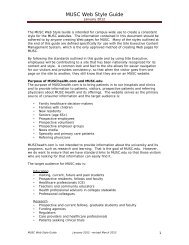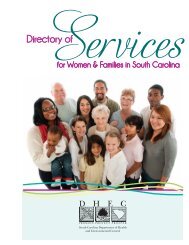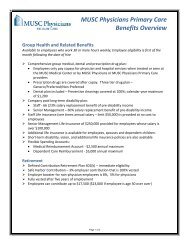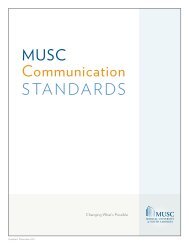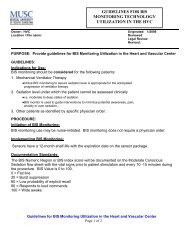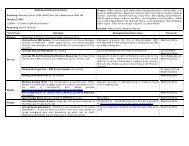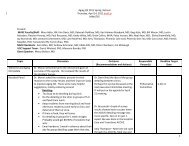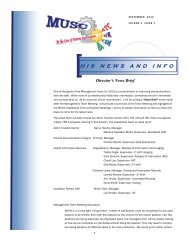"Medication Interventions for Fall Prevention in the Older Adult." J
"Medication Interventions for Fall Prevention in the Older Adult." J
"Medication Interventions for Fall Prevention in the Older Adult." J
Create successful ePaper yourself
Turn your PDF publications into a flip-book with our unique Google optimized e-Paper software.
Reviews <strong>Fall</strong> prevention <strong>in</strong> older adultsdevice that summons help when one is unable to ambulateor needs assistance. A cell phone kept on <strong>the</strong> patient is ano<strong>the</strong>rsimple method <strong>for</strong> lett<strong>in</strong>g caregivers know that helpis needed (onl<strong>in</strong>e Appendix 1).Comprehensive strategyA comprehensive fall-reduction strategy that addresses allfour of <strong>the</strong> above areas can be effective. However, many previousef<strong>for</strong>ts have been hampered by several factors:(1) Failure to consider all possible causes of falls, especiallymedications and <strong>the</strong> need <strong>for</strong> physical assistance to improvestrength and ambulation ability.(2) Failure to translate research <strong>in</strong>to practice, especially whenmedications are concerned. (This article concentrates onremedy<strong>in</strong>g this apparent failure.)(3) Lack of coord<strong>in</strong>ation among <strong>in</strong>terested but disparate organizationsthat support <strong>the</strong> older adult and <strong>the</strong>ir caregivers.(4) M<strong>in</strong>imization and trivialization of <strong>the</strong> issue, sometimesthrough media images cast<strong>in</strong>g older people as powerlessand pa<strong>the</strong>tic (e.g, <strong>the</strong> “I’ve fallen and I can’t get up” commercials).(5) Scarcity of approaches that are culturally sensitive and appropriate<strong>for</strong> older adults of all literacy levels. <strong>Adult</strong> daycareand senior centers, as well as assisted-liv<strong>in</strong>g and personalcare facilities, are ideal locations <strong>for</strong> tra<strong>in</strong><strong>in</strong>g bothpatients and caregivers to decrease fall risk. Onl<strong>in</strong>e Appendix1 has numerous resources that document <strong>the</strong>se factorsand can aide educational ef<strong>for</strong>ts.Numerous studies show <strong>the</strong> benefit of multifactorial fallrisk <strong>in</strong>terventions and improved outcomes with comprehensivestrategy implementation, and guidel<strong>in</strong>es <strong>for</strong> fall preventionhave been published. 35–43Psychoactive drug medication <strong>in</strong>terventions are limited by<strong>the</strong> lack of validation of currently available assessment <strong>in</strong>struments;most falls are caused by multiple risk factors that alsoshould be taken <strong>in</strong>to account but are not covered <strong>in</strong> this review(e.g., gait assessment, strength tra<strong>in</strong><strong>in</strong>g, environmental assessmentand changes). Onl<strong>in</strong>e Appendix 1 lists resources thatmay be of value <strong>in</strong> fall risk-reduction educational programs.<strong>Fall</strong> risk assessment methods<strong>Fall</strong>s <strong>in</strong> <strong>the</strong> older patient clearly lead to <strong>in</strong>creased healthcare use and decreased functional status. 1 A fall risk <strong>in</strong>dexbased on <strong>the</strong> number of chronic disabilities has been advocated.2 Earlier studies of fall factors, <strong>in</strong>cidence, and morbidityfound that those who susta<strong>in</strong>ed falls were more likely to be suffer<strong>in</strong>gfrom dementia, were prescribed more sedat<strong>in</strong>g drugs,and had abnormal balance and gait compared with age- andsex-matched control patients. In addition, orthostasis, arthritides,<strong>in</strong>cont<strong>in</strong>ence, and strokes were more prevalent <strong>in</strong> <strong>the</strong>sepatients. 3–5 A fall risk assessment that <strong>in</strong>corporates psychotropicand o<strong>the</strong>r psychoactive medications has been developed(Figure 1), 6 and medications implicated <strong>in</strong> falls have beendescribed. 7 A multifactorial <strong>in</strong>tervention to reduce <strong>the</strong> risk offall<strong>in</strong>g among <strong>the</strong> elderly liv<strong>in</strong>g <strong>in</strong> <strong>the</strong> community has been developed.8Basic patient assessment method <strong>for</strong> pharmacistsThe pharmacist may benefit from us<strong>in</strong>g a universal problem-orientedmedical record (POMR) or medication <strong>the</strong>rapymanagement (MTM) method to assess and recommendchanges <strong>in</strong> <strong>the</strong> patients’ drug regimen 51 as well as physical andlaboratory assessments that may be needed to optimize drug<strong>the</strong>rapy. We developed an onl<strong>in</strong>e 15-hour (1.5–cont<strong>in</strong>u<strong>in</strong>g educationunit) course on physical and laboratory assessment of<strong>the</strong> older adult; it is available at www.rxugace.com or www.shca-ga.org.The POMR method has four steps:(1) Per<strong>for</strong>m a history of patients problems, <strong>in</strong>clud<strong>in</strong>g past andcurrent diagnoses, conditions, all medications, past operations,immunizations, and adverse drug reactions, as wellas abnormal physical and lab f<strong>in</strong>d<strong>in</strong>gs that need to be addressed.Some practitioners prefer to group problems byorgan system (e.g., cardiovascular, endocr<strong>in</strong>e, pulmonary,gastro<strong>in</strong>test<strong>in</strong>al, genitour<strong>in</strong>ary, neuropsychiatric, dermatologic).(2) Match <strong>the</strong> medications found with <strong>the</strong> problems list; actionmay be needed if <strong>the</strong>re are medications or problems that donot match or are not addressed.(3) Assess how adequately each problem is be<strong>in</strong>g addressedby us<strong>in</strong>g <strong>the</strong> SOAP method <strong>for</strong> each problem: subjective (S)or compla<strong>in</strong>ts of <strong>the</strong> patient; objective (O) or th<strong>in</strong>gs thatcan be assigned numerical values such as physical f<strong>in</strong>d<strong>in</strong>gsof <strong>the</strong> vital signs of blood pressure, pulse, respiration,and temperature and lab values; assessment (A) of S and Of<strong>in</strong>d<strong>in</strong>gs <strong>for</strong> each problem; and plan (P) <strong>for</strong> communicationof <strong>the</strong> assessment of each problem.(4) Communication of <strong>the</strong> problems that need to be addressedto <strong>the</strong> appropriate prescriber, patients and <strong>the</strong>ir caregivers,and adm<strong>in</strong>istrators responsible <strong>for</strong> <strong>the</strong> patient is <strong>the</strong>most important step of <strong>the</strong> process.The POMR process may be thought of as a part of <strong>the</strong> MTMprocess. The American Pharmacists Association (APhA) andNational Association of Cha<strong>in</strong> Drug Stores released version 2.0of an MTM service model, which can be downloaded at www.nacdsfoundation.org, and a certificate tra<strong>in</strong><strong>in</strong>g program developedby APhA and <strong>the</strong> American Society of Consultant Pharmacistsis available at www.pharmacist.com.Def<strong>in</strong>itionsPsychotropics are def<strong>in</strong>ed as anxiolytics, hypnotics, antipsychotics,and antidepressants. Psychoactives or central nervoussystem (CNS)-active agents <strong>in</strong>clude psychotropics and <strong>the</strong>prok<strong>in</strong>etic agent metoclopramide, narcotic or opioid analgesics,antipark<strong>in</strong>son agents, anticonvulsants, muscle relaxants,antihistam<strong>in</strong>es, and centrally act<strong>in</strong>g antihypertensives. 7A patient’s total psychoactive drug load is best def<strong>in</strong>edas <strong>the</strong> total number of psychotropic and o<strong>the</strong>r psychoactivemedications given on a regular (i.e., at least weekly) basis. Asneededmedications given on a less-than-weekly basis may beconsidered relevant if <strong>the</strong>ir usage occurred with<strong>in</strong> 1 week of afall and <strong>the</strong> drugs <strong>in</strong>volved were antipsychotics or longer-act<strong>in</strong>gbenzodiazep<strong>in</strong>es (BZs). 7e72 • JAPhA • 49:3 • M a y /Ju n 2009www.japha.orgJournal of <strong>the</strong> American Pharmacists Association





